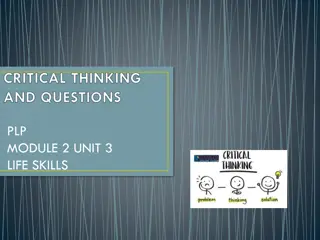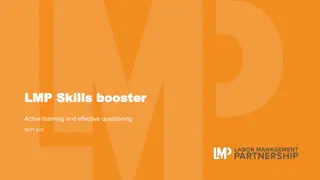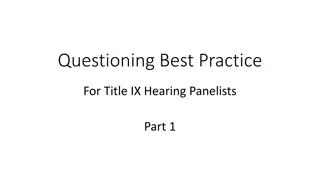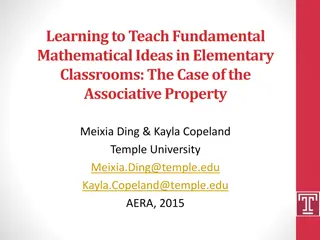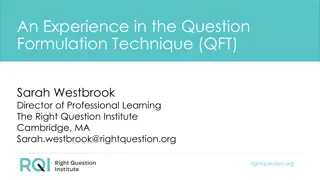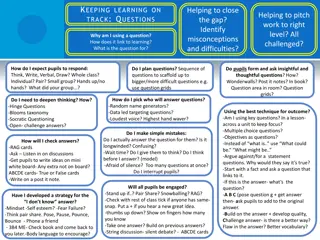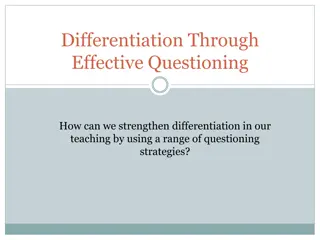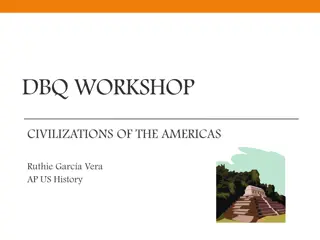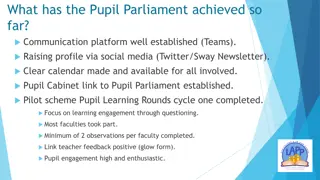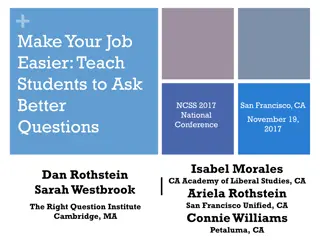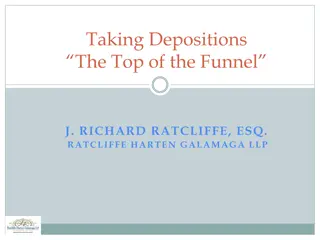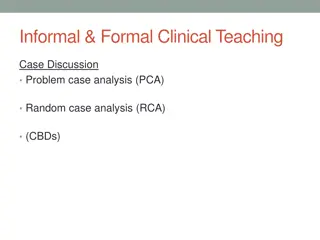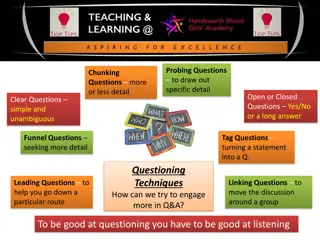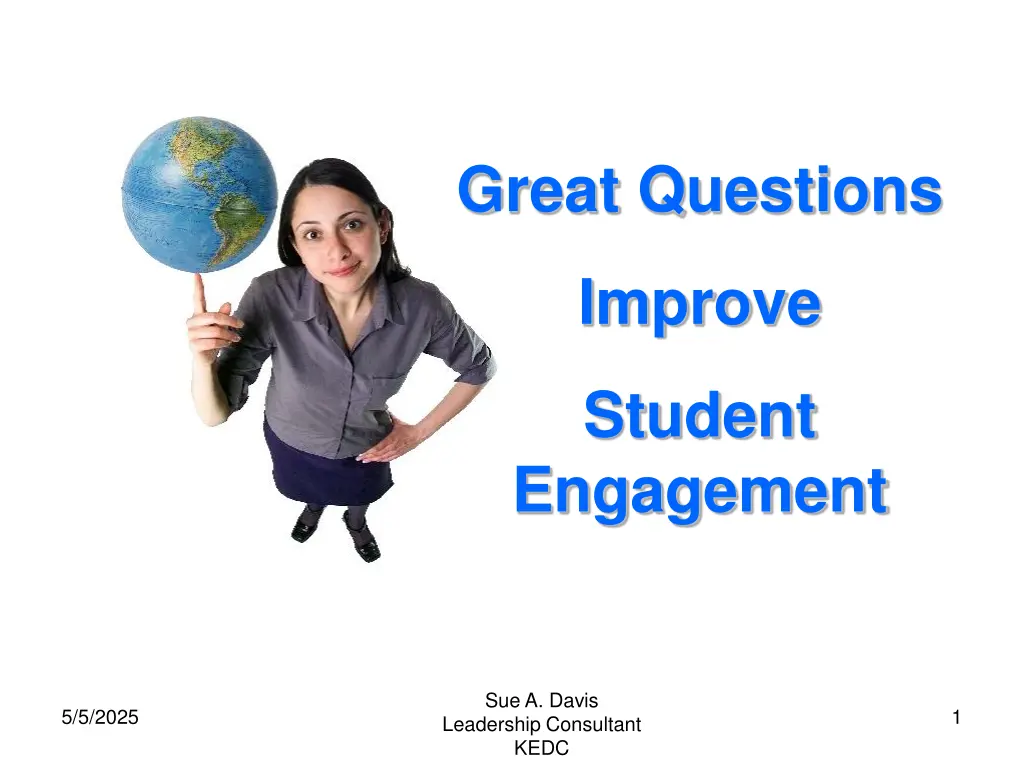
Enhancing Student Engagement through Effective Questioning Techniques
Explore insights from Sue A. Davis, a Leadership Consultant at KEDC, on the significance of using impactful questioning strategies to engage students effectively. Discover the benefits, purposes, and methods of incorporating questions into teaching practices to improve student learning outcomes and critical thinking skills.
Download Presentation

Please find below an Image/Link to download the presentation.
The content on the website is provided AS IS for your information and personal use only. It may not be sold, licensed, or shared on other websites without obtaining consent from the author. If you encounter any issues during the download, it is possible that the publisher has removed the file from their server.
You are allowed to download the files provided on this website for personal or commercial use, subject to the condition that they are used lawfully. All files are the property of their respective owners.
The content on the website is provided AS IS for your information and personal use only. It may not be sold, licensed, or shared on other websites without obtaining consent from the author.
E N D
Presentation Transcript
Great Questions Improve Student Engagement Sue A. Davis Leadership Consultant KEDC 5/5/2025 1
What do the gurus (experts) say about questions and learning? 5/5/2025 Sue A. Davis Leadership Consultant KEDC 2
When you see Him, What is expected of all students or What is the benefit to students. When you see Her, Questioning strategies or Teacher actions. 5/5/2025 Sue A. Davis Leadership Consultant KEDC 3
In general, research shows that instruction involving questioning is more effective than instruction without questioning. 5/5/2025 Sue A. Davis Leadership Consultant KEDC 4
Teachers often have little or no training in questioning techniques, so being familiar with the research is a good place to start. Improving in this area requires a reflective and metacognitive approach. 5/5/2025 Sue A. Davis Leadership Consultant KEDC 5
WHY ASK QUESTIONS? Teachers ask questions for a variety of purposes, including: To actively involve students in the lesson To increase motivation or interest To evaluate students preparation To check on completion of work 5/5/2025 Sue A. Davis Leadership Consultant KEDC 6
To develop critical thinking skills To review previous lessons To nurture insights To assess achievement or mastery of goals and objectives To stimulate independent learning 5/5/2025 Sue A. Davis Leadership Consultant KEDC 7
One important finding is that questions that focus student attention on important elements of a lesson result in better comprehension than those that focus on unusual or interesting elements. 5/5/2025 Sue A. Davis Leadership Consultant KEDC 8
A teacher may vary his or her purpose in asking questions during a single lesson, or a single question may have more than one purpose. 5/5/2025 Sue A. Davis Leadership Consultant KEDC 9
John Dewey What s in a question you ask? EVERYTHING. It is a way of evoking stimulating response or stultifying inquiry. In essence, it is the core of teaching. 5/5/2025 Sue A. Davis Leadership Consultant KEDC 10
J. T. Dillon An educative question is purposeful, clearly focused, carefully conceived and well- formulated. It does not occur in our mind; we must find it. It does not take on a shape; we must give it form. It does not present itself; we must deliver it. To conceive it requires thought, to formulate it requires labor, and to pose it, tact. 5/5/2025 Sue A. Davis Leadership Consultant KEDC 11
An Educative Question must be designed by the teacher An Educative Question must be designed by the teacher 1.In view of a particular purpose 1.As it relates to the task at hand; 2.In consideration of a discrete content focus 2.As it reflects the curriculum and CCSS; 3.Relative to the use of a determined level of cognition 3.And it reviews, extends or challenges student thinking. 5/5/2025 Sue A. Davis Leadership Consultant KEDC 12
An Educative Question 1) Increases student engagement in the curriculum 2) Helps students to focus on what is important 3) Improves the rate and degree of student learning 4) Enhances the transfer of learning to other areas 5/5/2025 Sue A. Davis Leadership Consultant KEDC 13
An Educative Question must be designed by the teacher 1.In view of a particular purpose 2.In consideration of a discrete content focus 3.Relative to the use of a determined level of cognition 5/5/2025 Sue A. Davis Leadership Consultant KEDC 14
Two Contexts for Oral Questioning Recitation 1. What is in question is not the thing the question asks about. 2. Answers are known before asking and confirmed after asking. 3. The questioner reacts to the answer with an evaluation as to its correctness. 5/5/2025 Sue A. Davis Leadership Consultant KEDC 15
Two Contexts for Oral Questioning Discussion 1. Questions are open for discussion rather than closed for an answer. 2. The teacher is NOT the source of the answer. 3. Discussion is characterized by an exchange of talk. 5/5/2025 Sue A. Davis Leadership Consultant KEDC 16
Purpose of Question Recitation Discussion To get students to talk To get students to think To review and assess what is known To work out understanding of content Role of Teacher Recitation Discussion Speaks at every turn Speaks in questions Evaluates the student answers as to correctness Does not speak at every turn, but yields floor to students Does not always speak in questions but also makes comments Poses question for discussion Asks questions that perplex self 5/5/2025 Sue A. Davis Leadership Consultant KEDC 17
Recitation questions should be structured so that most elicit correct responses. 5/5/2025 Sue A. Davis Leadership Consultant KEDC 18
We are not referring to questions that fill class time or that are carelessly lifted from teacher s manuals, programs, or other sources. We are referring to Educative Questions. 5/5/2025 Sue A. Davis Leadership Consultant KEDC 26
How does an educative question relate to an LDC Module? 4 minutes: 1 for thinking; 3 for listening to and sharing with others 5/5/2025 Sue A. Davis Leadership Consultant KEDC 27
Time ! Use it wisely! Plan for its use. Keep kids on the clock. Quick estimate: age + 2 for attention span. Never forget your most precious resource is Time ! 5/5/2025 Sue A. Davis Leadership Consultant KEDC 28
5/5/2025 Sue A. Davis Leadership Consultant KEDC 29
5/5/2025 Sue A. Davis Leadership Consultant KEDC 30
Five student behaviors that boost their ability to pay attention: S L A N T Sit Up. Listen. Ask and answer questions. Nod your head. Track the speaker. 5/5/2025 Sue A. Davis Leadership Consultant KEDC 31
Managing Time for Instruction and Wait Time Less than 10% of class time should be spent on classroom clerical duties. 60% or more classroom time should be spent on instructional activity with active participation the consistent engagement of the mind of all the learners with that being learned. 30% or less should be spent on facilitation of learning or guided practice of the curriculum 5/5/2025 Sue A. Davis Leadership Consultant KEDC 32
Some Cautions for our Students include: Build in the opportunity to pass Put them on the clock for extended activities (Tell them, you have 1 minute to answer correctly ) Direct Instruction / Questioning Time K-3 Less than 5 min. followed by activity or application Age + 2. 4-7 5:2 8-12 8:2 5/5/2025 Sue A. Davis Leadership Consultant KEDC 33
Follow a series of steps so they can successfully respond to the question. Adjust your answer after hearing others ! Share your answer ! Keep your answer a secret! Decipher the Question ! Attend to the Question ! 5/5/2025 Sue A. Davis Leadership Consultant KEDC 34
Wait Time : the time you give to a student to process information Steps: Pose the question Wait Time I: pause 3-5 seconds after posing the question Student Responds Wait Time II: pause at least 3-5 seconds after the student responds Other students complete their thinking 5/5/2025 Sue A. Davis Leadership Consultant KEDC 35
Managing Time and Wait Time 1) Improvements in student achievement 2) Increases in the number of higher cognitive responses generated by students 3) Increases in the length of student responses 4) Increases in the number of unsolicited responses 5) Decreases in students failure to respond 6) Increases in the amount and quality of evidence students offer to support their inferences 5/5/2025 Sue A. Davis Leadership Consultant KEDC 36
Managing Time and Wait Time (cont) 7) Increases in contributions by students who do not participate much when wait- time is under three seconds 8) Expansion of the variety of responses offered by students 9) Decreases in student interruptions 10)Increases in student to student interactions around content 11)Increases in the number of questions posed by students 5/5/2025 Sue A. Davis Leadership Consultant KEDC 37
Increasing Wait Time beyond 3 seconds is positively related to the following teacher outcomes: 1) Increases in flexibility of teachers responses, with teachers listening more and engaging students in more discussions 2) Increases in teacher expectations regarding students usually regarded as slow 3) Expansion of the variety of questions asked by teachers 4) Increases in the number of higher cognitive questions asked by teachers 5/5/2025 Sue A. Davis Leadership Consultant KEDC 38
Other Ways for Students to Respond to Questions Signaled Response: Have every student signal the answer. Example: thumbs up if true, thumbs down if false, to the side if not sure. Work Samples: Have students write their answers (chalk or white boards, large cardstock); teacher circulates or students hold up answers. 5/5/2025 Sue A. Davis Leadership Consultant KEDC 39
Other Ways for Students to Respond to Questions Pairs Check: Students work in four- person teams (two pairs consisting of a coach and worker each). Pairs complete a short assignment that reinforces lessons, checking answers with the other half of their team. Coaches and workers trade jobs after each problem. Individual Responses: Yes, sometimes you just have to call out someone s name to bring them out of the fog. 5/5/2025 Sue A. Davis Leadership Consultant KEDC 40



